Siemens Case Study: Corruption Issues, Impact & Recommendations
VerifiedAdded on 2023/04/22
|12
|2957
|282
Case Study
AI Summary
This case study examines the corruption issues faced by Siemens, a multinational company investigated for bribery and corruption in 2007. It identifies the causes of the corruption problem, including bribery, money laundering, tax evasion, and unauthorized money transfers. The scope of these problems includes economic losses, damage to public image, and employee trust issues. The study discusses how the company attempted to address these issues through internal investigations and highlights the importance of anti-bribery and anti-corruption policies, risk assessment, top-level commitment, and due diligence. It also introduces the BS10500 anti-bribery management system as a potential solution. The case study further analyzes the Siemens employee case in Italy, where managers were found guilty of bribery, and provides recommendations for removing corruption and bribery, including implementing an effective anti-corruption system, promoting transparency and professional accountability, and raising awareness among employees. Desklib provides access to this and other solved assignments for students.
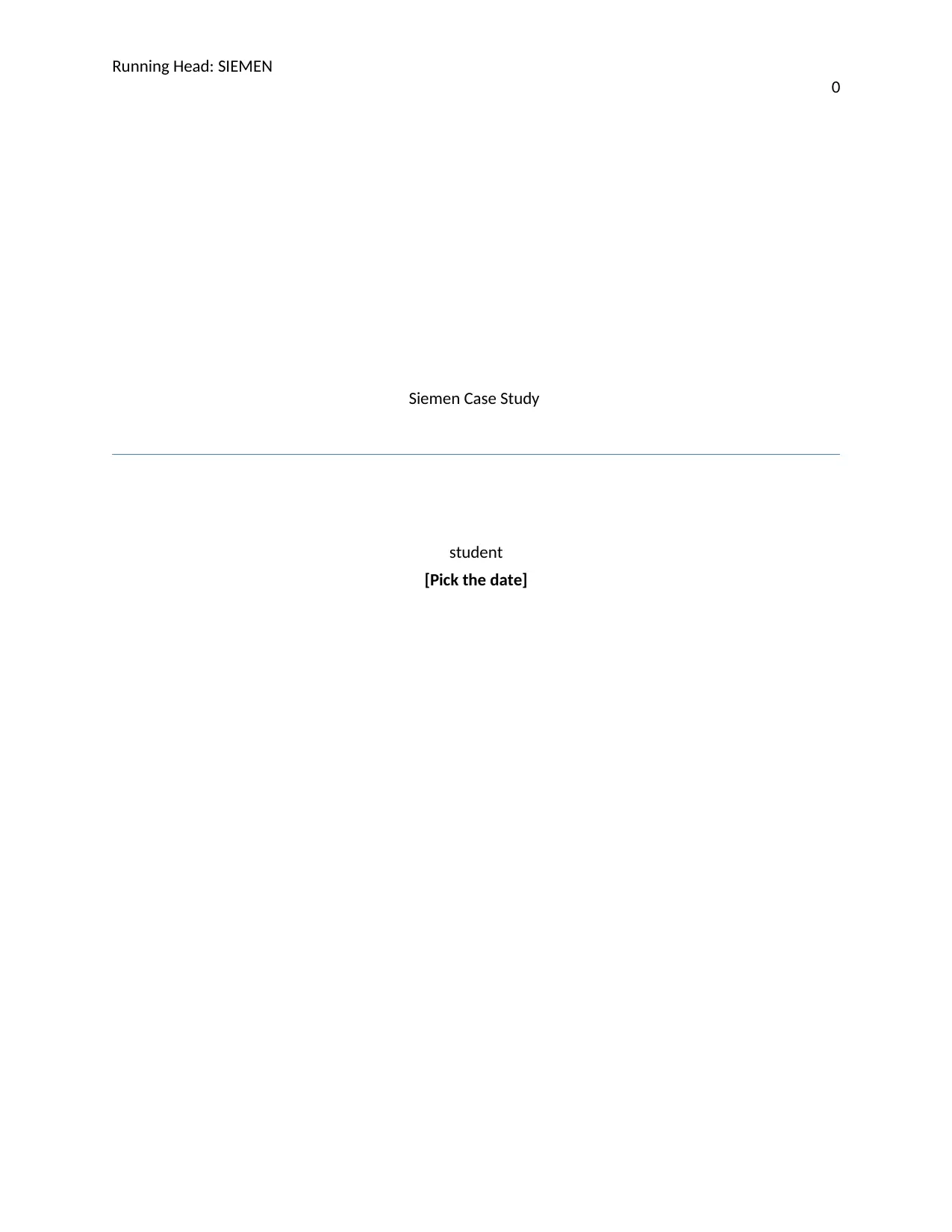
Running Head: SIEMEN
0
Siemen Case Study
student
[Pick the date]
0
Siemen Case Study
student
[Pick the date]
Paraphrase This Document
Need a fresh take? Get an instant paraphrase of this document with our AI Paraphraser
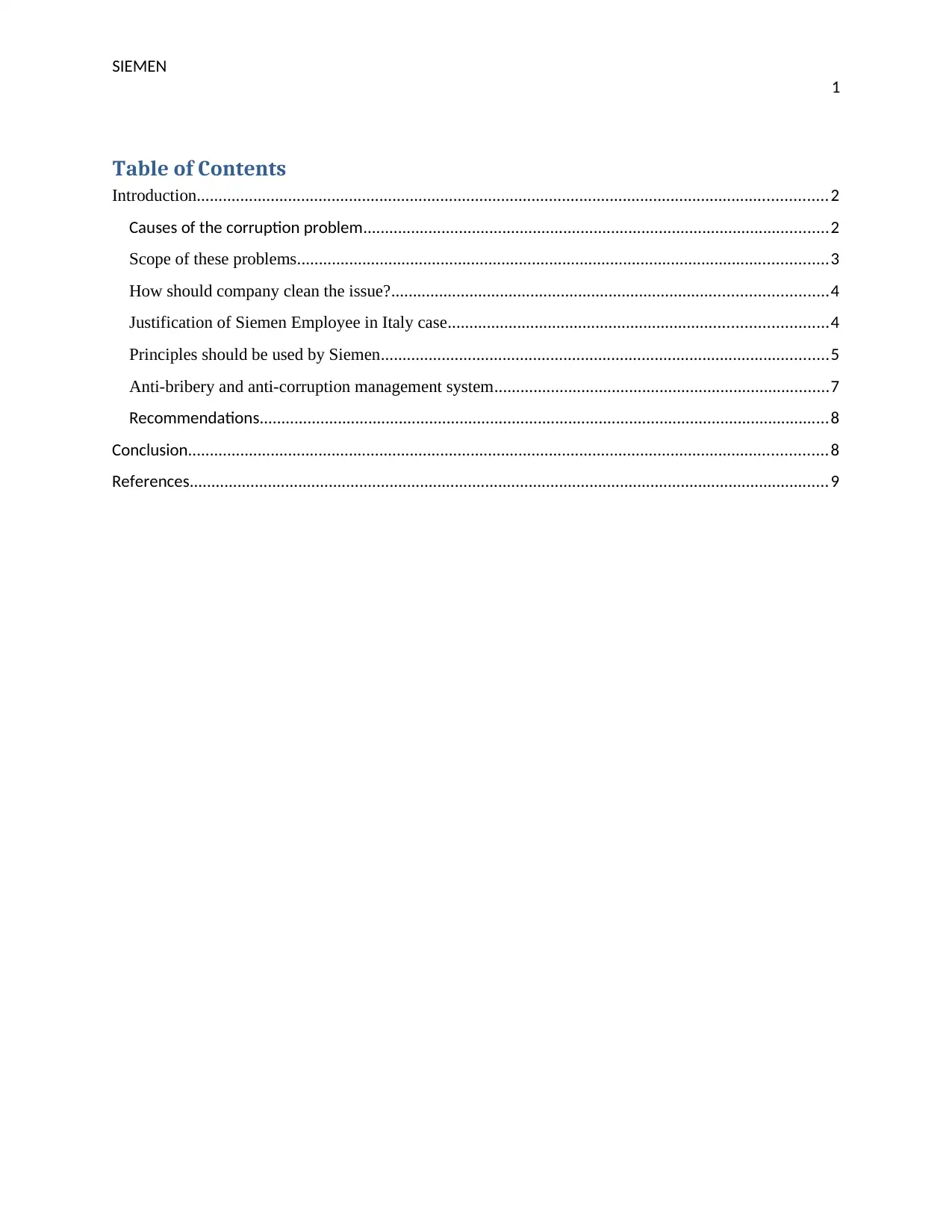
SIEMEN
1
Table of Contents
Introduction.................................................................................................................................................2
Causes of the corruption problem...........................................................................................................2
Scope of these problems..........................................................................................................................3
How should company clean the issue?....................................................................................................4
Justification of Siemen Employee in Italy case.......................................................................................4
Principles should be used by Siemen.......................................................................................................5
Anti-bribery and anti-corruption management system.............................................................................7
Recommendations...................................................................................................................................8
Conclusion...................................................................................................................................................8
References...................................................................................................................................................9
1
Table of Contents
Introduction.................................................................................................................................................2
Causes of the corruption problem...........................................................................................................2
Scope of these problems..........................................................................................................................3
How should company clean the issue?....................................................................................................4
Justification of Siemen Employee in Italy case.......................................................................................4
Principles should be used by Siemen.......................................................................................................5
Anti-bribery and anti-corruption management system.............................................................................7
Recommendations...................................................................................................................................8
Conclusion...................................................................................................................................................8
References...................................................................................................................................................9
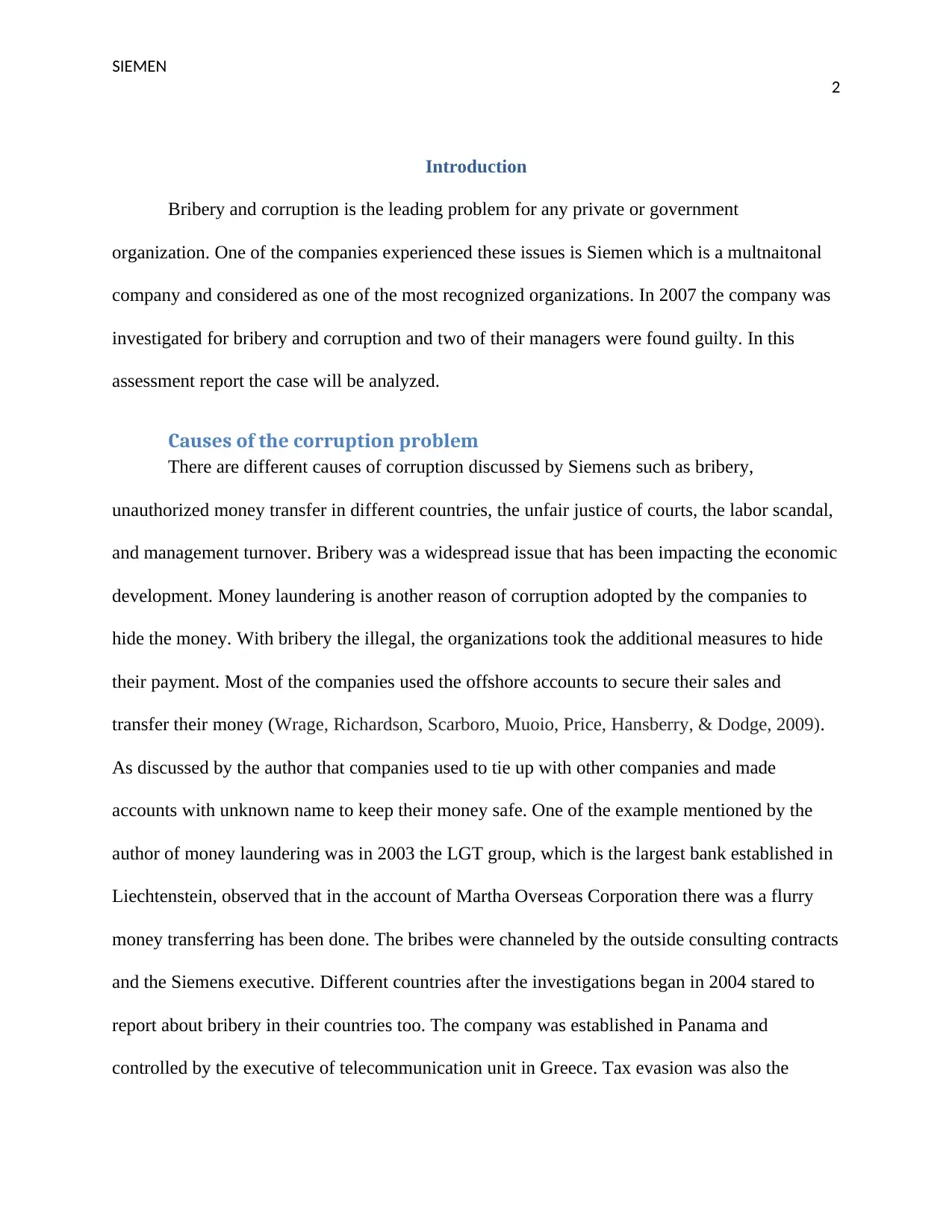
SIEMEN
2
Introduction
Bribery and corruption is the leading problem for any private or government
organization. One of the companies experienced these issues is Siemen which is a multnaitonal
company and considered as one of the most recognized organizations. In 2007 the company was
investigated for bribery and corruption and two of their managers were found guilty. In this
assessment report the case will be analyzed.
Causes of the corruption problem
There are different causes of corruption discussed by Siemens such as bribery,
unauthorized money transfer in different countries, the unfair justice of courts, the labor scandal,
and management turnover. Bribery was a widespread issue that has been impacting the economic
development. Money laundering is another reason of corruption adopted by the companies to
hide the money. With bribery the illegal, the organizations took the additional measures to hide
their payment. Most of the companies used the offshore accounts to secure their sales and
transfer their money (Wrage, Richardson, Scarboro, Muoio, Price, Hansberry, & Dodge, 2009).
As discussed by the author that companies used to tie up with other companies and made
accounts with unknown name to keep their money safe. One of the example mentioned by the
author of money laundering was in 2003 the LGT group, which is the largest bank established in
Liechtenstein, observed that in the account of Martha Overseas Corporation there was a flurry
money transferring has been done. The bribes were channeled by the outside consulting contracts
and the Siemens executive. Different countries after the investigations began in 2004 stared to
report about bribery in their countries too. The company was established in Panama and
controlled by the executive of telecommunication unit in Greece. Tax evasion was also the
2
Introduction
Bribery and corruption is the leading problem for any private or government
organization. One of the companies experienced these issues is Siemen which is a multnaitonal
company and considered as one of the most recognized organizations. In 2007 the company was
investigated for bribery and corruption and two of their managers were found guilty. In this
assessment report the case will be analyzed.
Causes of the corruption problem
There are different causes of corruption discussed by Siemens such as bribery,
unauthorized money transfer in different countries, the unfair justice of courts, the labor scandal,
and management turnover. Bribery was a widespread issue that has been impacting the economic
development. Money laundering is another reason of corruption adopted by the companies to
hide the money. With bribery the illegal, the organizations took the additional measures to hide
their payment. Most of the companies used the offshore accounts to secure their sales and
transfer their money (Wrage, Richardson, Scarboro, Muoio, Price, Hansberry, & Dodge, 2009).
As discussed by the author that companies used to tie up with other companies and made
accounts with unknown name to keep their money safe. One of the example mentioned by the
author of money laundering was in 2003 the LGT group, which is the largest bank established in
Liechtenstein, observed that in the account of Martha Overseas Corporation there was a flurry
money transferring has been done. The bribes were channeled by the outside consulting contracts
and the Siemens executive. Different countries after the investigations began in 2004 stared to
report about bribery in their countries too. The company was established in Panama and
controlled by the executive of telecommunication unit in Greece. Tax evasion was also the
⊘ This is a preview!⊘
Do you want full access?
Subscribe today to unlock all pages.

Trusted by 1+ million students worldwide
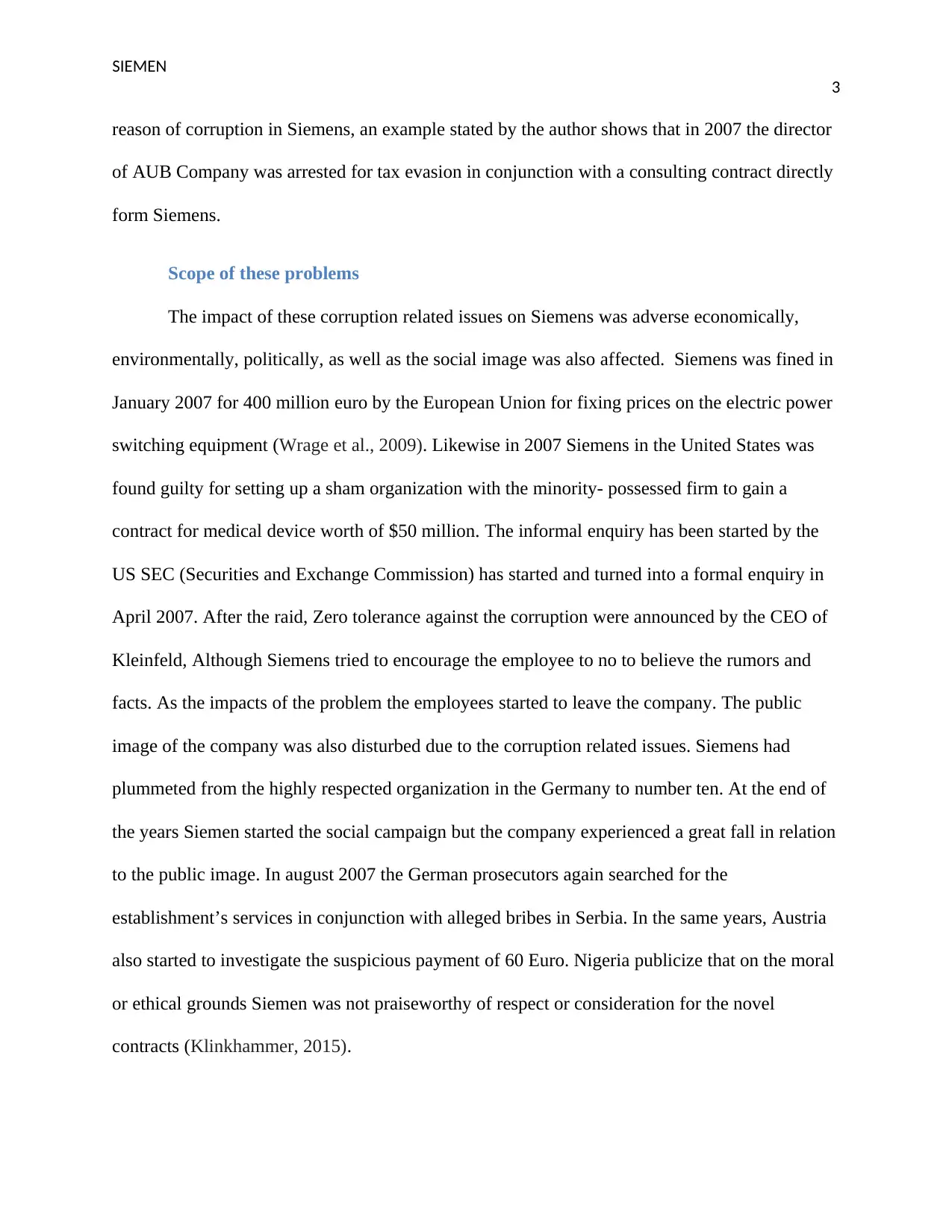
SIEMEN
3
reason of corruption in Siemens, an example stated by the author shows that in 2007 the director
of AUB Company was arrested for tax evasion in conjunction with a consulting contract directly
form Siemens.
Scope of these problems
The impact of these corruption related issues on Siemens was adverse economically,
environmentally, politically, as well as the social image was also affected. Siemens was fined in
January 2007 for 400 million euro by the European Union for fixing prices on the electric power
switching equipment (Wrage et al., 2009). Likewise in 2007 Siemens in the United States was
found guilty for setting up a sham organization with the minority- possessed firm to gain a
contract for medical device worth of $50 million. The informal enquiry has been started by the
US SEC (Securities and Exchange Commission) has started and turned into a formal enquiry in
April 2007. After the raid, Zero tolerance against the corruption were announced by the CEO of
Kleinfeld, Although Siemens tried to encourage the employee to no to believe the rumors and
facts. As the impacts of the problem the employees started to leave the company. The public
image of the company was also disturbed due to the corruption related issues. Siemens had
plummeted from the highly respected organization in the Germany to number ten. At the end of
the years Siemen started the social campaign but the company experienced a great fall in relation
to the public image. In august 2007 the German prosecutors again searched for the
establishment’s services in conjunction with alleged bribes in Serbia. In the same years, Austria
also started to investigate the suspicious payment of 60 Euro. Nigeria publicize that on the moral
or ethical grounds Siemen was not praiseworthy of respect or consideration for the novel
contracts (Klinkhammer, 2015).
3
reason of corruption in Siemens, an example stated by the author shows that in 2007 the director
of AUB Company was arrested for tax evasion in conjunction with a consulting contract directly
form Siemens.
Scope of these problems
The impact of these corruption related issues on Siemens was adverse economically,
environmentally, politically, as well as the social image was also affected. Siemens was fined in
January 2007 for 400 million euro by the European Union for fixing prices on the electric power
switching equipment (Wrage et al., 2009). Likewise in 2007 Siemens in the United States was
found guilty for setting up a sham organization with the minority- possessed firm to gain a
contract for medical device worth of $50 million. The informal enquiry has been started by the
US SEC (Securities and Exchange Commission) has started and turned into a formal enquiry in
April 2007. After the raid, Zero tolerance against the corruption were announced by the CEO of
Kleinfeld, Although Siemens tried to encourage the employee to no to believe the rumors and
facts. As the impacts of the problem the employees started to leave the company. The public
image of the company was also disturbed due to the corruption related issues. Siemens had
plummeted from the highly respected organization in the Germany to number ten. At the end of
the years Siemen started the social campaign but the company experienced a great fall in relation
to the public image. In august 2007 the German prosecutors again searched for the
establishment’s services in conjunction with alleged bribes in Serbia. In the same years, Austria
also started to investigate the suspicious payment of 60 Euro. Nigeria publicize that on the moral
or ethical grounds Siemen was not praiseworthy of respect or consideration for the novel
contracts (Klinkhammer, 2015).
Paraphrase This Document
Need a fresh take? Get an instant paraphrase of this document with our AI Paraphraser
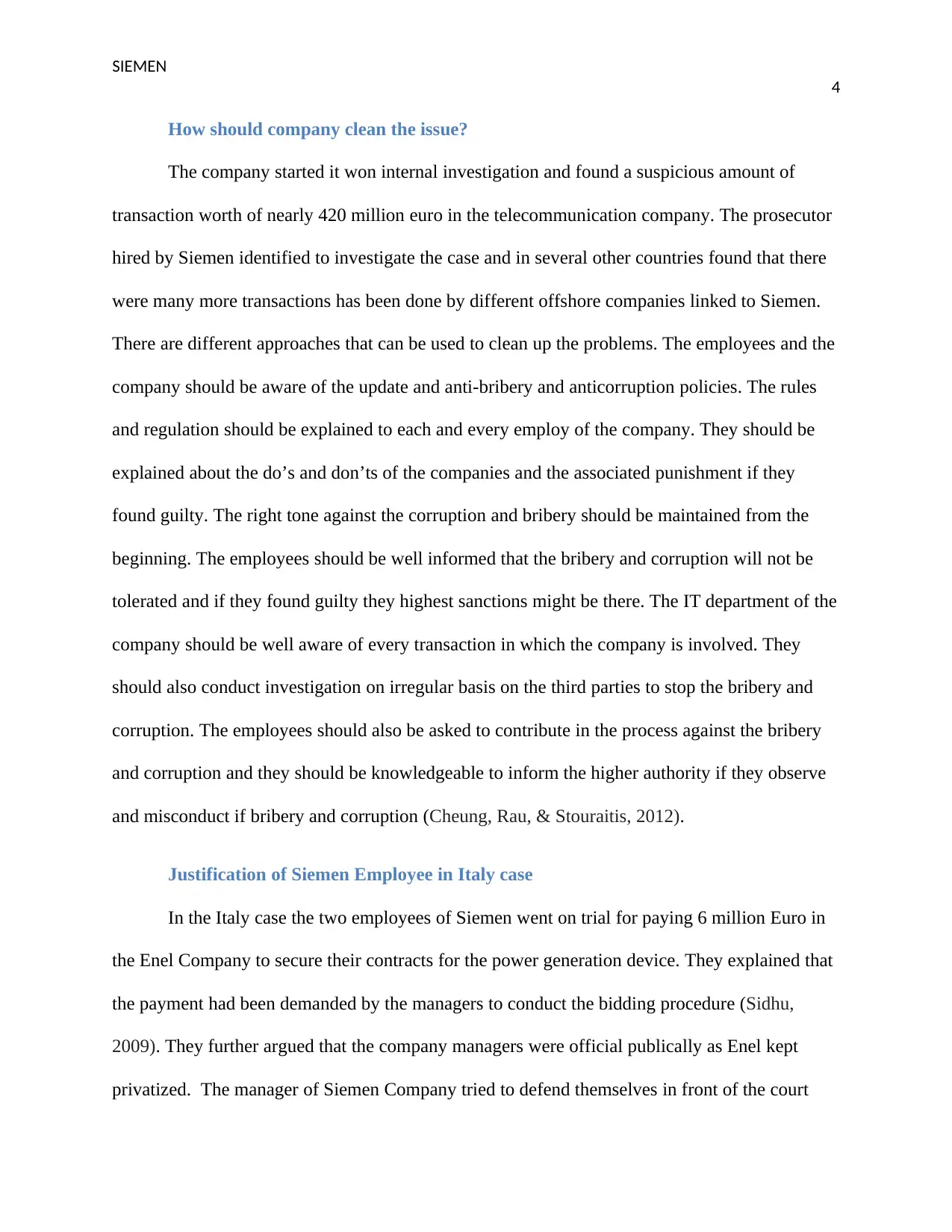
SIEMEN
4
How should company clean the issue?
The company started it won internal investigation and found a suspicious amount of
transaction worth of nearly 420 million euro in the telecommunication company. The prosecutor
hired by Siemen identified to investigate the case and in several other countries found that there
were many more transactions has been done by different offshore companies linked to Siemen.
There are different approaches that can be used to clean up the problems. The employees and the
company should be aware of the update and anti-bribery and anticorruption policies. The rules
and regulation should be explained to each and every employ of the company. They should be
explained about the do’s and don’ts of the companies and the associated punishment if they
found guilty. The right tone against the corruption and bribery should be maintained from the
beginning. The employees should be well informed that the bribery and corruption will not be
tolerated and if they found guilty they highest sanctions might be there. The IT department of the
company should be well aware of every transaction in which the company is involved. They
should also conduct investigation on irregular basis on the third parties to stop the bribery and
corruption. The employees should also be asked to contribute in the process against the bribery
and corruption and they should be knowledgeable to inform the higher authority if they observe
and misconduct if bribery and corruption (Cheung, Rau, & Stouraitis, 2012).
Justification of Siemen Employee in Italy case
In the Italy case the two employees of Siemen went on trial for paying 6 million Euro in
the Enel Company to secure their contracts for the power generation device. They explained that
the payment had been demanded by the managers to conduct the bidding procedure (Sidhu,
2009). They further argued that the company managers were official publically as Enel kept
privatized. The manager of Siemen Company tried to defend themselves in front of the court
4
How should company clean the issue?
The company started it won internal investigation and found a suspicious amount of
transaction worth of nearly 420 million euro in the telecommunication company. The prosecutor
hired by Siemen identified to investigate the case and in several other countries found that there
were many more transactions has been done by different offshore companies linked to Siemen.
There are different approaches that can be used to clean up the problems. The employees and the
company should be aware of the update and anti-bribery and anticorruption policies. The rules
and regulation should be explained to each and every employ of the company. They should be
explained about the do’s and don’ts of the companies and the associated punishment if they
found guilty. The right tone against the corruption and bribery should be maintained from the
beginning. The employees should be well informed that the bribery and corruption will not be
tolerated and if they found guilty they highest sanctions might be there. The IT department of the
company should be well aware of every transaction in which the company is involved. They
should also conduct investigation on irregular basis on the third parties to stop the bribery and
corruption. The employees should also be asked to contribute in the process against the bribery
and corruption and they should be knowledgeable to inform the higher authority if they observe
and misconduct if bribery and corruption (Cheung, Rau, & Stouraitis, 2012).
Justification of Siemen Employee in Italy case
In the Italy case the two employees of Siemen went on trial for paying 6 million Euro in
the Enel Company to secure their contracts for the power generation device. They explained that
the payment had been demanded by the managers to conduct the bidding procedure (Sidhu,
2009). They further argued that the company managers were official publically as Enel kept
privatized. The manager of Siemen Company tried to defend themselves in front of the court
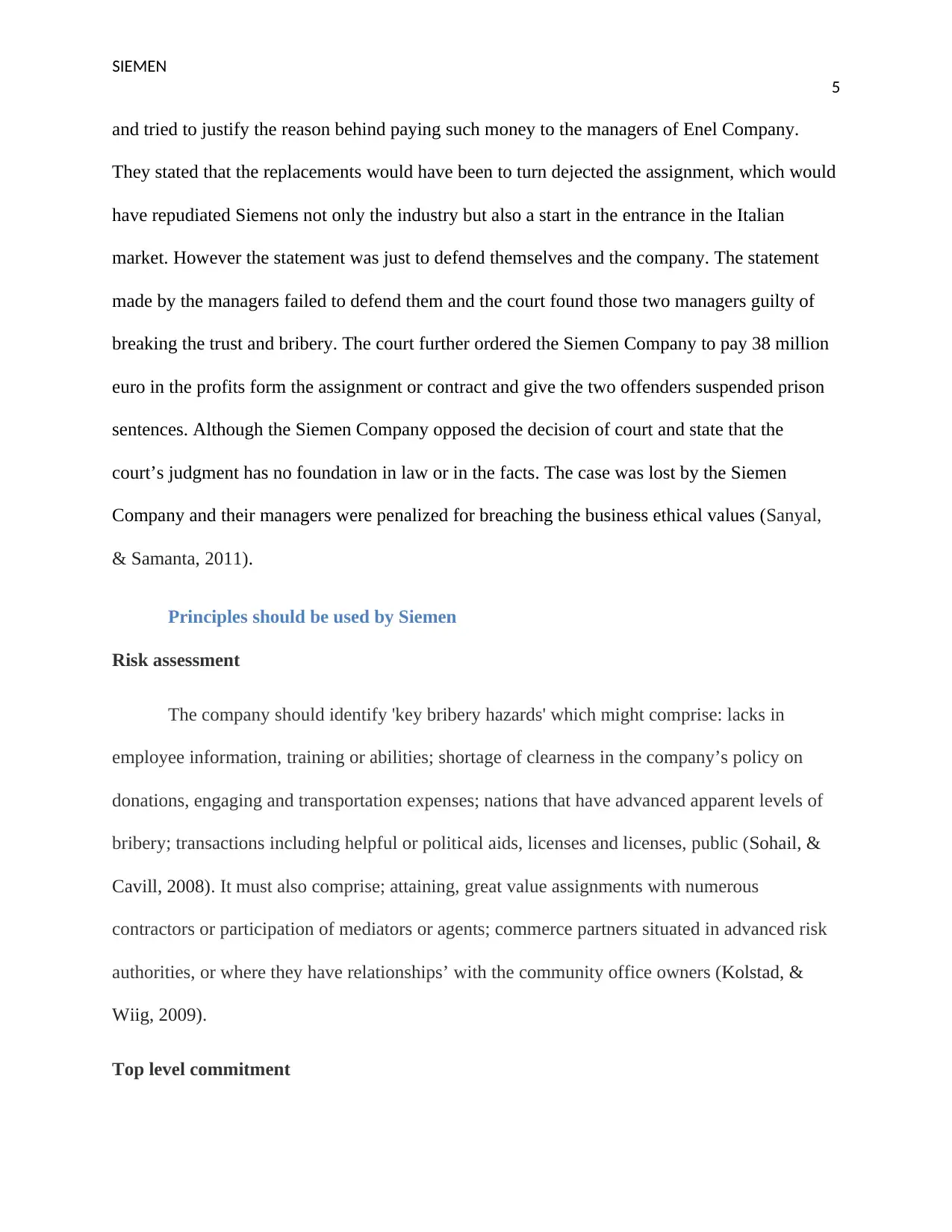
SIEMEN
5
and tried to justify the reason behind paying such money to the managers of Enel Company.
They stated that the replacements would have been to turn dejected the assignment, which would
have repudiated Siemens not only the industry but also a start in the entrance in the Italian
market. However the statement was just to defend themselves and the company. The statement
made by the managers failed to defend them and the court found those two managers guilty of
breaking the trust and bribery. The court further ordered the Siemen Company to pay 38 million
euro in the profits form the assignment or contract and give the two offenders suspended prison
sentences. Although the Siemen Company opposed the decision of court and state that the
court’s judgment has no foundation in law or in the facts. The case was lost by the Siemen
Company and their managers were penalized for breaching the business ethical values (Sanyal,
& Samanta, 2011).
Principles should be used by Siemen
Risk assessment
The company should identify 'key bribery hazards' which might comprise: lacks in
employee information, training or abilities; shortage of clearness in the company’s policy on
donations, engaging and transportation expenses; nations that have advanced apparent levels of
bribery; transactions including helpful or political aids, licenses and licenses, public (Sohail, &
Cavill, 2008). It must also comprise; attaining, great value assignments with numerous
contractors or participation of mediators or agents; commerce partners situated in advanced risk
authorities, or where they have relationships’ with the community office owners (Kolstad, &
Wiig, 2009).
Top level commitment
5
and tried to justify the reason behind paying such money to the managers of Enel Company.
They stated that the replacements would have been to turn dejected the assignment, which would
have repudiated Siemens not only the industry but also a start in the entrance in the Italian
market. However the statement was just to defend themselves and the company. The statement
made by the managers failed to defend them and the court found those two managers guilty of
breaking the trust and bribery. The court further ordered the Siemen Company to pay 38 million
euro in the profits form the assignment or contract and give the two offenders suspended prison
sentences. Although the Siemen Company opposed the decision of court and state that the
court’s judgment has no foundation in law or in the facts. The case was lost by the Siemen
Company and their managers were penalized for breaching the business ethical values (Sanyal,
& Samanta, 2011).
Principles should be used by Siemen
Risk assessment
The company should identify 'key bribery hazards' which might comprise: lacks in
employee information, training or abilities; shortage of clearness in the company’s policy on
donations, engaging and transportation expenses; nations that have advanced apparent levels of
bribery; transactions including helpful or political aids, licenses and licenses, public (Sohail, &
Cavill, 2008). It must also comprise; attaining, great value assignments with numerous
contractors or participation of mediators or agents; commerce partners situated in advanced risk
authorities, or where they have relationships’ with the community office owners (Kolstad, &
Wiig, 2009).
Top level commitment
⊘ This is a preview!⊘
Do you want full access?
Subscribe today to unlock all pages.

Trusted by 1+ million students worldwide
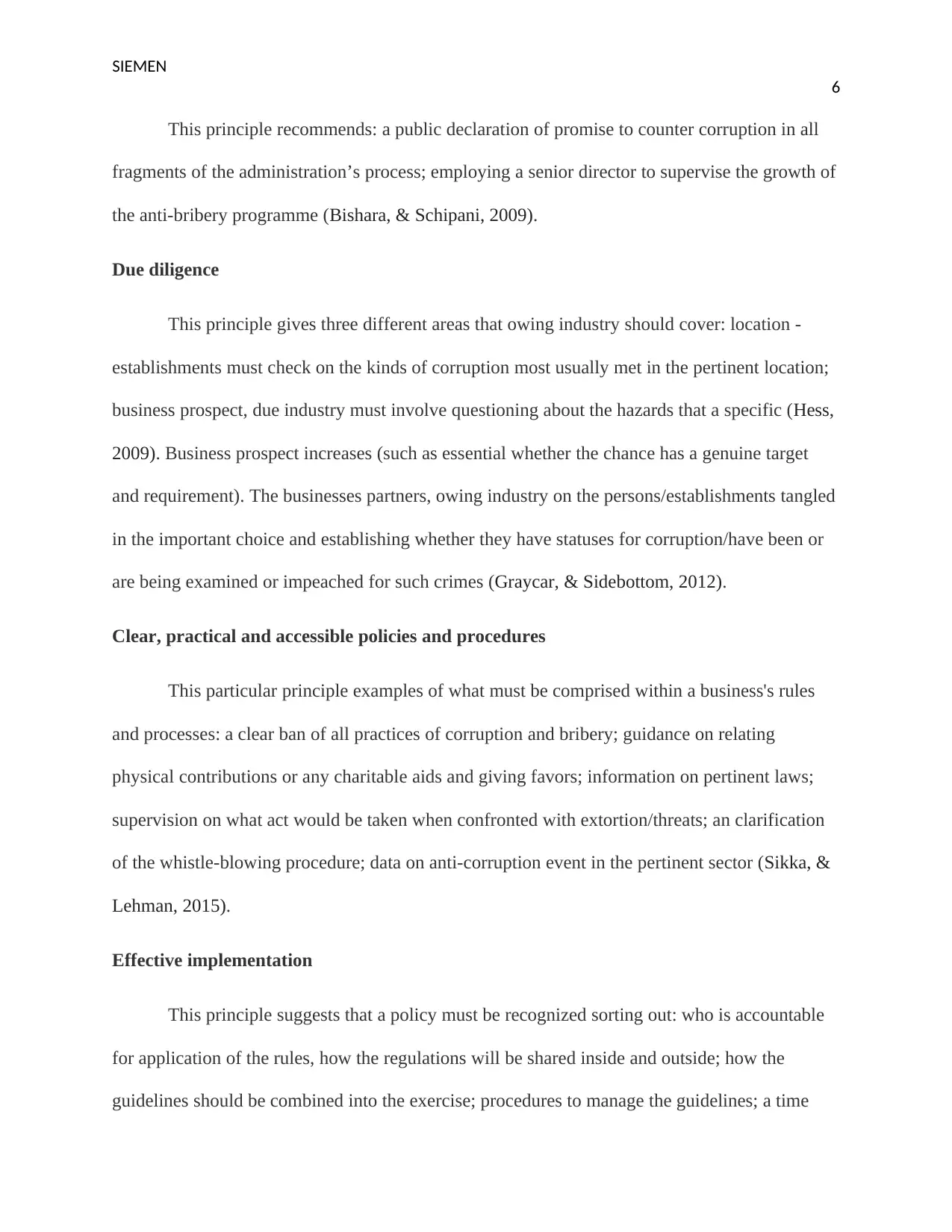
SIEMEN
6
This principle recommends: a public declaration of promise to counter corruption in all
fragments of the administration’s process; employing a senior director to supervise the growth of
the anti-bribery programme (Bishara, & Schipani, 2009).
Due diligence
This principle gives three different areas that owing industry should cover: location -
establishments must check on the kinds of corruption most usually met in the pertinent location;
business prospect, due industry must involve questioning about the hazards that a specific (Hess,
2009). Business prospect increases (such as essential whether the chance has a genuine target
and requirement). The businesses partners, owing industry on the persons/establishments tangled
in the important choice and establishing whether they have statuses for corruption/have been or
are being examined or impeached for such crimes (Graycar, & Sidebottom, 2012).
Clear, practical and accessible policies and procedures
This particular principle examples of what must be comprised within a business's rules
and processes: a clear ban of all practices of corruption and bribery; guidance on relating
physical contributions or any charitable aids and giving favors; information on pertinent laws;
supervision on what act would be taken when confronted with extortion/threats; an clarification
of the whistle-blowing procedure; data on anti-corruption event in the pertinent sector (Sikka, &
Lehman, 2015).
Effective implementation
This principle suggests that a policy must be recognized sorting out: who is accountable
for application of the rules, how the regulations will be shared inside and outside; how the
guidelines should be combined into the exercise; procedures to manage the guidelines; a time
6
This principle recommends: a public declaration of promise to counter corruption in all
fragments of the administration’s process; employing a senior director to supervise the growth of
the anti-bribery programme (Bishara, & Schipani, 2009).
Due diligence
This principle gives three different areas that owing industry should cover: location -
establishments must check on the kinds of corruption most usually met in the pertinent location;
business prospect, due industry must involve questioning about the hazards that a specific (Hess,
2009). Business prospect increases (such as essential whether the chance has a genuine target
and requirement). The businesses partners, owing industry on the persons/establishments tangled
in the important choice and establishing whether they have statuses for corruption/have been or
are being examined or impeached for such crimes (Graycar, & Sidebottom, 2012).
Clear, practical and accessible policies and procedures
This particular principle examples of what must be comprised within a business's rules
and processes: a clear ban of all practices of corruption and bribery; guidance on relating
physical contributions or any charitable aids and giving favors; information on pertinent laws;
supervision on what act would be taken when confronted with extortion/threats; an clarification
of the whistle-blowing procedure; data on anti-corruption event in the pertinent sector (Sikka, &
Lehman, 2015).
Effective implementation
This principle suggests that a policy must be recognized sorting out: who is accountable
for application of the rules, how the regulations will be shared inside and outside; how the
guidelines should be combined into the exercise; procedures to manage the guidelines; a time
Paraphrase This Document
Need a fresh take? Get an instant paraphrase of this document with our AI Paraphraser
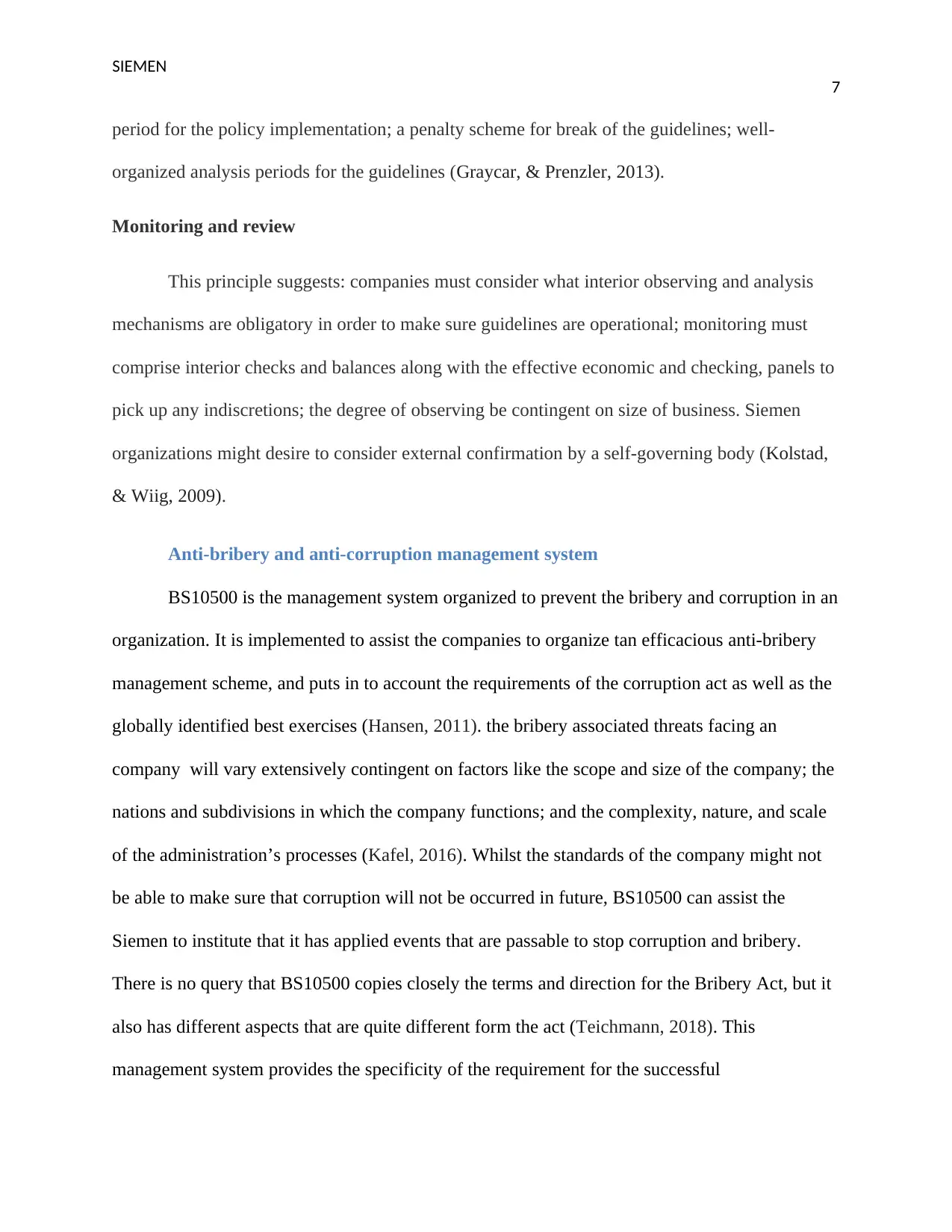
SIEMEN
7
period for the policy implementation; a penalty scheme for break of the guidelines; well-
organized analysis periods for the guidelines (Graycar, & Prenzler, 2013).
Monitoring and review
This principle suggests: companies must consider what interior observing and analysis
mechanisms are obligatory in order to make sure guidelines are operational; monitoring must
comprise interior checks and balances along with the effective economic and checking, panels to
pick up any indiscretions; the degree of observing be contingent on size of business. Siemen
organizations might desire to consider external confirmation by a self-governing body (Kolstad,
& Wiig, 2009).
Anti-bribery and anti-corruption management system
BS10500 is the management system organized to prevent the bribery and corruption in an
organization. It is implemented to assist the companies to organize tan efficacious anti-bribery
management scheme, and puts in to account the requirements of the corruption act as well as the
globally identified best exercises (Hansen, 2011). the bribery associated threats facing an
company will vary extensively contingent on factors like the scope and size of the company; the
nations and subdivisions in which the company functions; and the complexity, nature, and scale
of the administration’s processes (Kafel, 2016). Whilst the standards of the company might not
be able to make sure that corruption will not be occurred in future, BS10500 can assist the
Siemen to institute that it has applied events that are passable to stop corruption and bribery.
There is no query that BS10500 copies closely the terms and direction for the Bribery Act, but it
also has different aspects that are quite different form the act (Teichmann, 2018). This
management system provides the specificity of the requirement for the successful
7
period for the policy implementation; a penalty scheme for break of the guidelines; well-
organized analysis periods for the guidelines (Graycar, & Prenzler, 2013).
Monitoring and review
This principle suggests: companies must consider what interior observing and analysis
mechanisms are obligatory in order to make sure guidelines are operational; monitoring must
comprise interior checks and balances along with the effective economic and checking, panels to
pick up any indiscretions; the degree of observing be contingent on size of business. Siemen
organizations might desire to consider external confirmation by a self-governing body (Kolstad,
& Wiig, 2009).
Anti-bribery and anti-corruption management system
BS10500 is the management system organized to prevent the bribery and corruption in an
organization. It is implemented to assist the companies to organize tan efficacious anti-bribery
management scheme, and puts in to account the requirements of the corruption act as well as the
globally identified best exercises (Hansen, 2011). the bribery associated threats facing an
company will vary extensively contingent on factors like the scope and size of the company; the
nations and subdivisions in which the company functions; and the complexity, nature, and scale
of the administration’s processes (Kafel, 2016). Whilst the standards of the company might not
be able to make sure that corruption will not be occurred in future, BS10500 can assist the
Siemen to institute that it has applied events that are passable to stop corruption and bribery.
There is no query that BS10500 copies closely the terms and direction for the Bribery Act, but it
also has different aspects that are quite different form the act (Teichmann, 2018). This
management system provides the specificity of the requirement for the successful
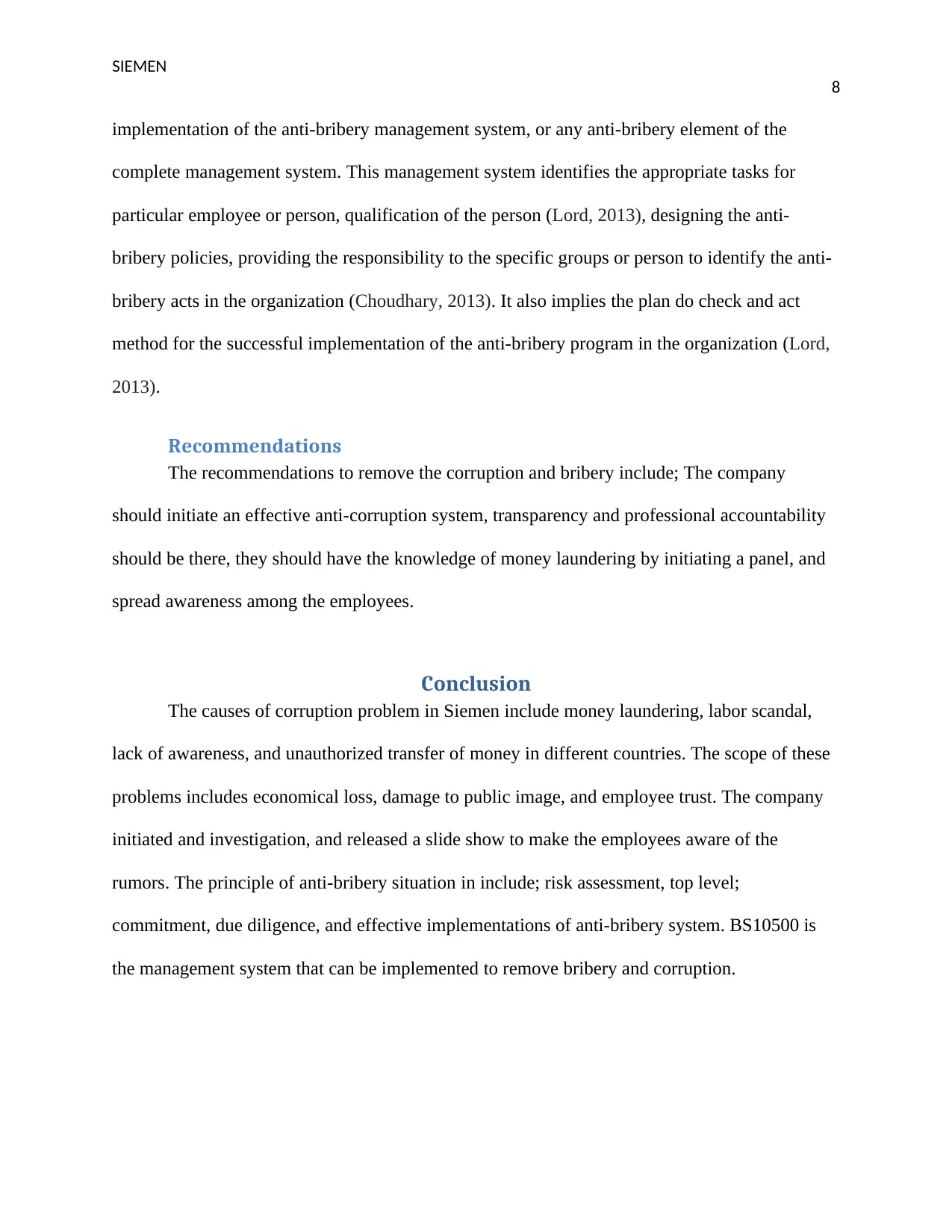
SIEMEN
8
implementation of the anti-bribery management system, or any anti-bribery element of the
complete management system. This management system identifies the appropriate tasks for
particular employee or person, qualification of the person (Lord, 2013), designing the anti-
bribery policies, providing the responsibility to the specific groups or person to identify the anti-
bribery acts in the organization (Choudhary, 2013). It also implies the plan do check and act
method for the successful implementation of the anti-bribery program in the organization (Lord,
2013).
Recommendations
The recommendations to remove the corruption and bribery include; The company
should initiate an effective anti-corruption system, transparency and professional accountability
should be there, they should have the knowledge of money laundering by initiating a panel, and
spread awareness among the employees.
Conclusion
The causes of corruption problem in Siemen include money laundering, labor scandal,
lack of awareness, and unauthorized transfer of money in different countries. The scope of these
problems includes economical loss, damage to public image, and employee trust. The company
initiated and investigation, and released a slide show to make the employees aware of the
rumors. The principle of anti-bribery situation in include; risk assessment, top level;
commitment, due diligence, and effective implementations of anti-bribery system. BS10500 is
the management system that can be implemented to remove bribery and corruption.
8
implementation of the anti-bribery management system, or any anti-bribery element of the
complete management system. This management system identifies the appropriate tasks for
particular employee or person, qualification of the person (Lord, 2013), designing the anti-
bribery policies, providing the responsibility to the specific groups or person to identify the anti-
bribery acts in the organization (Choudhary, 2013). It also implies the plan do check and act
method for the successful implementation of the anti-bribery program in the organization (Lord,
2013).
Recommendations
The recommendations to remove the corruption and bribery include; The company
should initiate an effective anti-corruption system, transparency and professional accountability
should be there, they should have the knowledge of money laundering by initiating a panel, and
spread awareness among the employees.
Conclusion
The causes of corruption problem in Siemen include money laundering, labor scandal,
lack of awareness, and unauthorized transfer of money in different countries. The scope of these
problems includes economical loss, damage to public image, and employee trust. The company
initiated and investigation, and released a slide show to make the employees aware of the
rumors. The principle of anti-bribery situation in include; risk assessment, top level;
commitment, due diligence, and effective implementations of anti-bribery system. BS10500 is
the management system that can be implemented to remove bribery and corruption.
⊘ This is a preview!⊘
Do you want full access?
Subscribe today to unlock all pages.

Trusted by 1+ million students worldwide
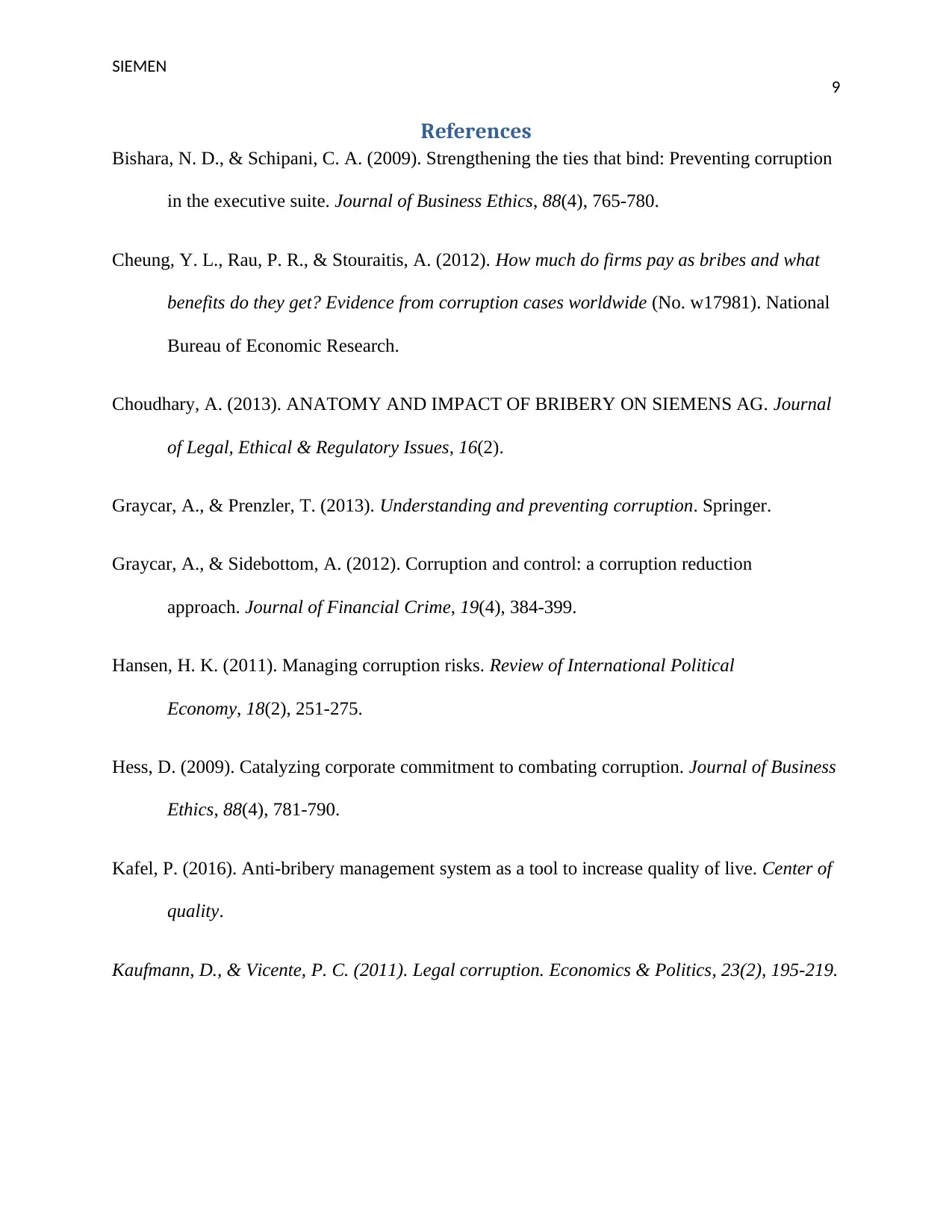
SIEMEN
9
References
Bishara, N. D., & Schipani, C. A. (2009). Strengthening the ties that bind: Preventing corruption
in the executive suite. Journal of Business Ethics, 88(4), 765-780.
Cheung, Y. L., Rau, P. R., & Stouraitis, A. (2012). How much do firms pay as bribes and what
benefits do they get? Evidence from corruption cases worldwide (No. w17981). National
Bureau of Economic Research.
Choudhary, A. (2013). ANATOMY AND IMPACT OF BRIBERY ON SIEMENS AG. Journal
of Legal, Ethical & Regulatory Issues, 16(2).
Graycar, A., & Prenzler, T. (2013). Understanding and preventing corruption. Springer.
Graycar, A., & Sidebottom, A. (2012). Corruption and control: a corruption reduction
approach. Journal of Financial Crime, 19(4), 384-399.
Hansen, H. K. (2011). Managing corruption risks. Review of International Political
Economy, 18(2), 251-275.
Hess, D. (2009). Catalyzing corporate commitment to combating corruption. Journal of Business
Ethics, 88(4), 781-790.
Kafel, P. (2016). Anti-bribery management system as a tool to increase quality of live. Center of
quality.
Kaufmann, D., & Vicente, P. C. (2011). Legal corruption. Economics & Politics, 23(2), 195-219.
9
References
Bishara, N. D., & Schipani, C. A. (2009). Strengthening the ties that bind: Preventing corruption
in the executive suite. Journal of Business Ethics, 88(4), 765-780.
Cheung, Y. L., Rau, P. R., & Stouraitis, A. (2012). How much do firms pay as bribes and what
benefits do they get? Evidence from corruption cases worldwide (No. w17981). National
Bureau of Economic Research.
Choudhary, A. (2013). ANATOMY AND IMPACT OF BRIBERY ON SIEMENS AG. Journal
of Legal, Ethical & Regulatory Issues, 16(2).
Graycar, A., & Prenzler, T. (2013). Understanding and preventing corruption. Springer.
Graycar, A., & Sidebottom, A. (2012). Corruption and control: a corruption reduction
approach. Journal of Financial Crime, 19(4), 384-399.
Hansen, H. K. (2011). Managing corruption risks. Review of International Political
Economy, 18(2), 251-275.
Hess, D. (2009). Catalyzing corporate commitment to combating corruption. Journal of Business
Ethics, 88(4), 781-790.
Kafel, P. (2016). Anti-bribery management system as a tool to increase quality of live. Center of
quality.
Kaufmann, D., & Vicente, P. C. (2011). Legal corruption. Economics & Politics, 23(2), 195-219.
Paraphrase This Document
Need a fresh take? Get an instant paraphrase of this document with our AI Paraphraser
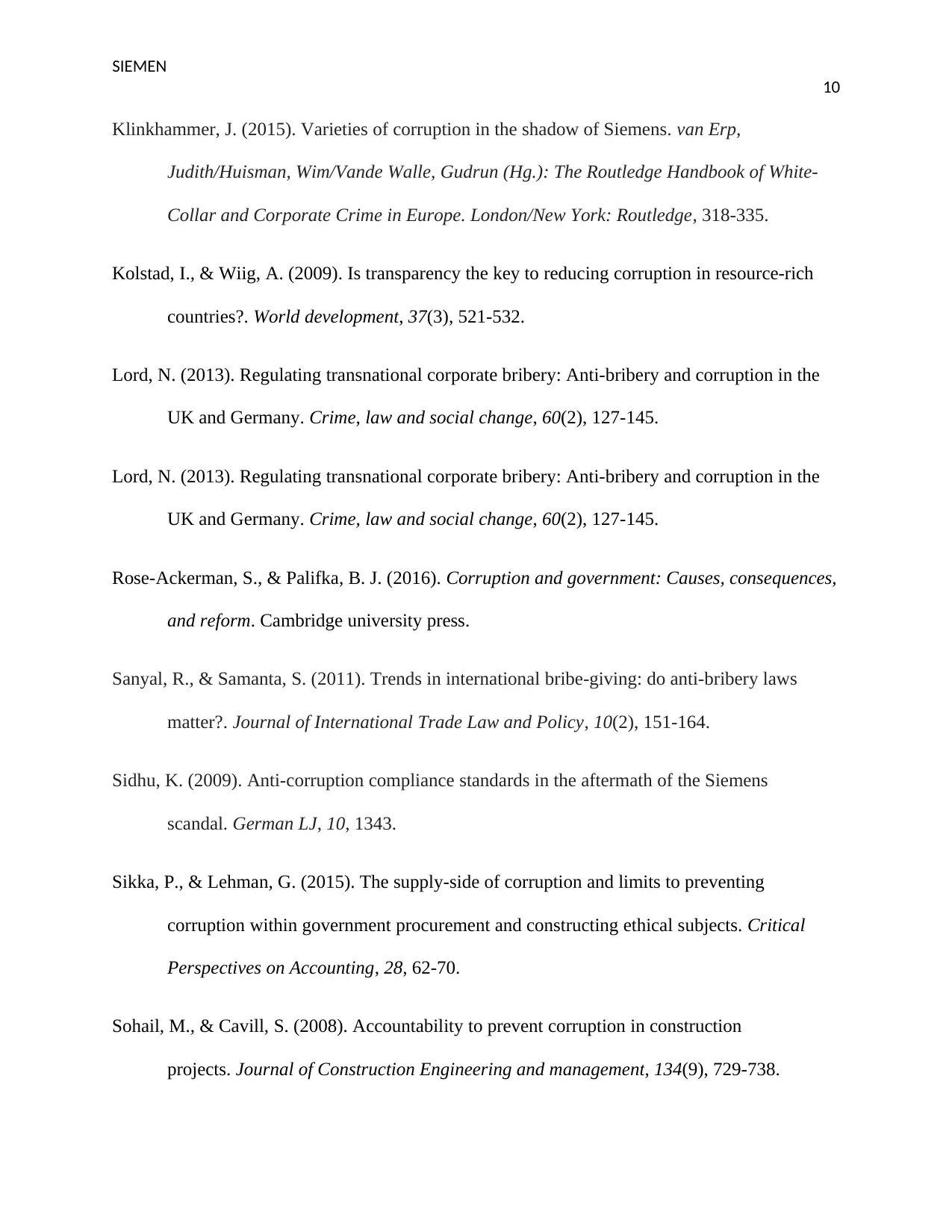
SIEMEN
10
Klinkhammer, J. (2015). Varieties of corruption in the shadow of Siemens. van Erp,
Judith/Huisman, Wim/Vande Walle, Gudrun (Hg.): The Routledge Handbook of White-
Collar and Corporate Crime in Europe. London/New York: Routledge, 318-335.
Kolstad, I., & Wiig, A. (2009). Is transparency the key to reducing corruption in resource-rich
countries?. World development, 37(3), 521-532.
Lord, N. (2013). Regulating transnational corporate bribery: Anti-bribery and corruption in the
UK and Germany. Crime, law and social change, 60(2), 127-145.
Lord, N. (2013). Regulating transnational corporate bribery: Anti-bribery and corruption in the
UK and Germany. Crime, law and social change, 60(2), 127-145.
Rose-Ackerman, S., & Palifka, B. J. (2016). Corruption and government: Causes, consequences,
and reform. Cambridge university press.
Sanyal, R., & Samanta, S. (2011). Trends in international bribe-giving: do anti-bribery laws
matter?. Journal of International Trade Law and Policy, 10(2), 151-164.
Sidhu, K. (2009). Anti-corruption compliance standards in the aftermath of the Siemens
scandal. German LJ, 10, 1343.
Sikka, P., & Lehman, G. (2015). The supply-side of corruption and limits to preventing
corruption within government procurement and constructing ethical subjects. Critical
Perspectives on Accounting, 28, 62-70.
Sohail, M., & Cavill, S. (2008). Accountability to prevent corruption in construction
projects. Journal of Construction Engineering and management, 134(9), 729-738.
10
Klinkhammer, J. (2015). Varieties of corruption in the shadow of Siemens. van Erp,
Judith/Huisman, Wim/Vande Walle, Gudrun (Hg.): The Routledge Handbook of White-
Collar and Corporate Crime in Europe. London/New York: Routledge, 318-335.
Kolstad, I., & Wiig, A. (2009). Is transparency the key to reducing corruption in resource-rich
countries?. World development, 37(3), 521-532.
Lord, N. (2013). Regulating transnational corporate bribery: Anti-bribery and corruption in the
UK and Germany. Crime, law and social change, 60(2), 127-145.
Lord, N. (2013). Regulating transnational corporate bribery: Anti-bribery and corruption in the
UK and Germany. Crime, law and social change, 60(2), 127-145.
Rose-Ackerman, S., & Palifka, B. J. (2016). Corruption and government: Causes, consequences,
and reform. Cambridge university press.
Sanyal, R., & Samanta, S. (2011). Trends in international bribe-giving: do anti-bribery laws
matter?. Journal of International Trade Law and Policy, 10(2), 151-164.
Sidhu, K. (2009). Anti-corruption compliance standards in the aftermath of the Siemens
scandal. German LJ, 10, 1343.
Sikka, P., & Lehman, G. (2015). The supply-side of corruption and limits to preventing
corruption within government procurement and constructing ethical subjects. Critical
Perspectives on Accounting, 28, 62-70.
Sohail, M., & Cavill, S. (2008). Accountability to prevent corruption in construction
projects. Journal of Construction Engineering and management, 134(9), 729-738.
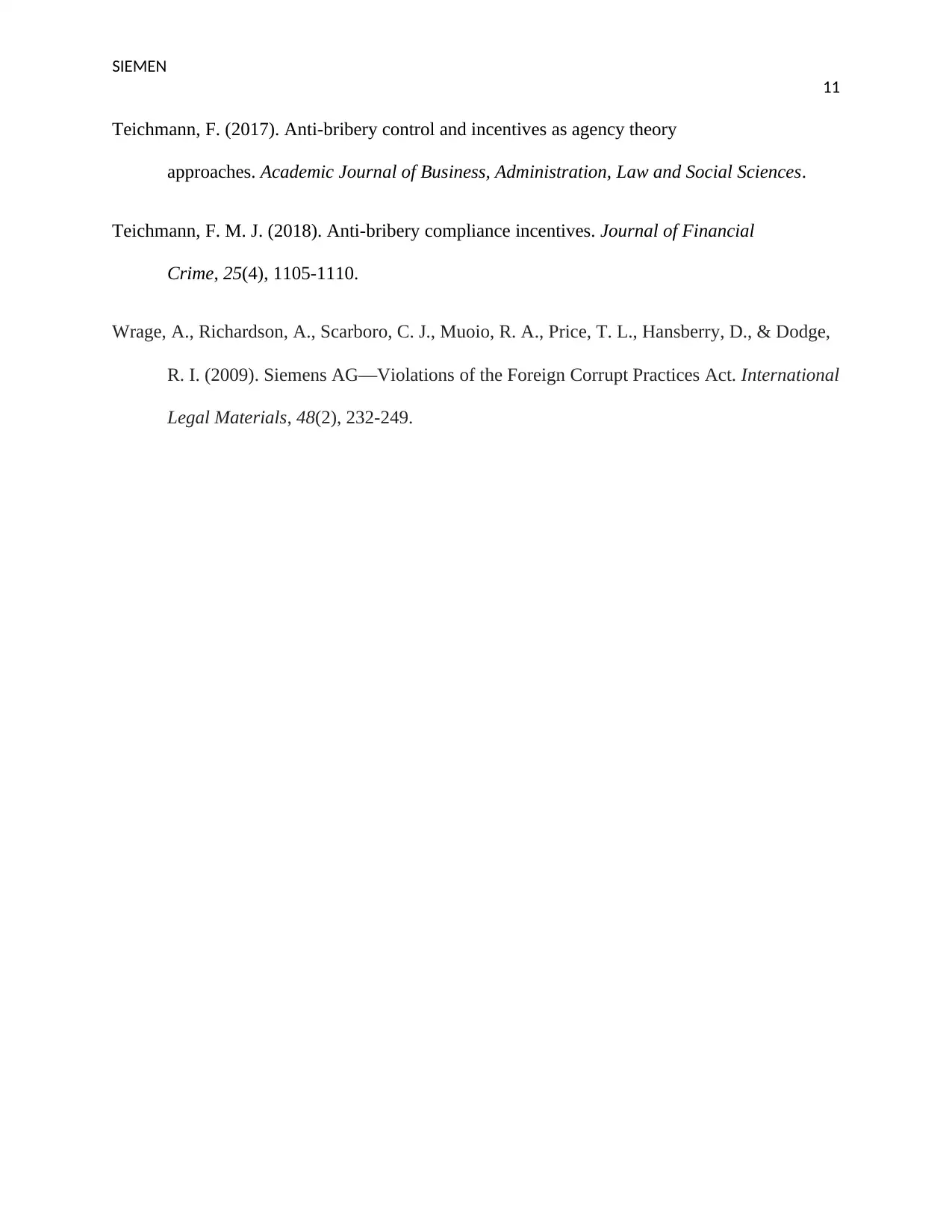
SIEMEN
11
Teichmann, F. (2017). Anti-bribery control and incentives as agency theory
approaches. Academic Journal of Business, Administration, Law and Social Sciences.
Teichmann, F. M. J. (2018). Anti-bribery compliance incentives. Journal of Financial
Crime, 25(4), 1105-1110.
Wrage, A., Richardson, A., Scarboro, C. J., Muoio, R. A., Price, T. L., Hansberry, D., & Dodge,
R. I. (2009). Siemens AG—Violations of the Foreign Corrupt Practices Act. International
Legal Materials, 48(2), 232-249.
11
Teichmann, F. (2017). Anti-bribery control and incentives as agency theory
approaches. Academic Journal of Business, Administration, Law and Social Sciences.
Teichmann, F. M. J. (2018). Anti-bribery compliance incentives. Journal of Financial
Crime, 25(4), 1105-1110.
Wrage, A., Richardson, A., Scarboro, C. J., Muoio, R. A., Price, T. L., Hansberry, D., & Dodge,
R. I. (2009). Siemens AG—Violations of the Foreign Corrupt Practices Act. International
Legal Materials, 48(2), 232-249.
⊘ This is a preview!⊘
Do you want full access?
Subscribe today to unlock all pages.

Trusted by 1+ million students worldwide
1 out of 12
Your All-in-One AI-Powered Toolkit for Academic Success.
+13062052269
info@desklib.com
Available 24*7 on WhatsApp / Email
![[object Object]](/_next/static/media/star-bottom.7253800d.svg)
Unlock your academic potential
Copyright © 2020–2025 A2Z Services. All Rights Reserved. Developed and managed by ZUCOL.


